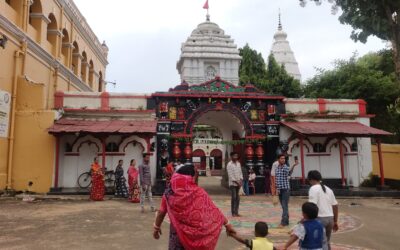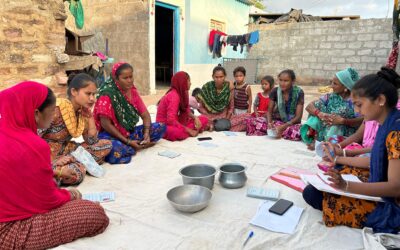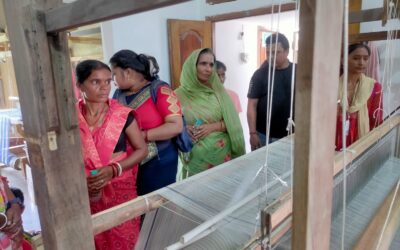One Saturday, I was returning from school with Pratap, a colleague who was telling me about an interactive session on ‘Open Schooling’ which was going to happen in Dantewada the same evening. I was curious about it and excited to attended the session. Dantewada is about 80km from Sukma. Before I could say anything, my colleague asked, “Would you also like to accompany us?”. “YES! Of course!”, was my immediate response.
We reached our house, freshened up, took the bike and left. The landscape during our journey was eye soothing with mountains, greenery all around, small villages on the way and cool air. The Sun was ready to set. Pratap had worked in Dantewada before shifting to Sukma. Hence, he was well aware about the routes and the organisation ‘Bachpan Banao’, which was hosting this session.
He stopped the bike in front of a cafe. I couldn’t imagine such a place in Dantewada where we could have Cold Coffee. The session that we were going to attend was about learning beyond chalk & board and classroom & books. It was arranged in an open space next to the cafe at 7pm. The temperature outside was 11 degree celsius. On dinner table, I was able to interact with the members of Bachpan Banao. They were planning to visit NMDC mines next morning, and I decided to go with them. Our stay for the night was at their campus, which was decorated with a variety of plants.

Next morning, we woke up to 8 degrees, and despite the cold, I was motivated to take a walk around the campus. In a while, I heard a bus honking, which was there to take us to the Bailadila NMDC mines. I was clueless about the schedule for some communication gap but we soon got ready and boarded the bus. Soon, we were on our way to the mines. I could see hills and huge pipes carrying some material. There was red soil all around which made roads, plants and vehicles turn red by covering itself around these things.

On reaching the hill top, we were allotted an instructor to guide us through the site. He took us to a point from where we could see the mines and the red land. It felt like I had landed on Mars. He told us about the types of iron ore found in the mine and that the iron percentage in the soil varies from 3% to 68%. The higher the percentage of iron, the higher is the quality of the soil. It also changes the color from dark red to grey.
The high quality material is crushed and later transported to ESSAR ltd. which is based down in the valley. Soil with less than 10% of iron is considered waste which is used to make artificial hills, gray in color. The team had plans to plant trees on these artificial hills to prevent the soil from flowing down during the rainy season. We asked the instructor if could step down and see the mine closely. He arranged a vehicle for us to explore. However, getting close to the mines was not allowed due to safety reasons.
Within two hours, they were planning to blow up the mines. We were informed that it would be better to leave in an hour as these blasts usually shake the whole Bailadila mountain range. Our guide also told us that it was named Bailadila because it looks like an Ox and is the Asia’s largest mechanized mine developed by Japan.
We got on our vehicle which took us for a round during which we saw water tankers sprinkling water around that area so that the soil doesn’t scatter. We were told that there are 14 deposits across 40km. Two mines are shut due to Naxal’s interference. Multiples vehicles have been blown up before, to stop the mining work. CRPF guards are seen in large numbers. There are multiple watch towers with 1 or 2 CRPF men holding guns and keeping an eye on every movement.
We asked the instructor about steps taken by NMDC to prevent ecological damage, and got to know that the NMDC is planting 8.9 lakh trees across Chhattisgarh through Harihar Chhattisgarh Campaign of the state government in order to make up for deforestation. They also sprinkle the water regularly and have covered the belts carrying iron ore to ESSAR so as to avoid air pollution. In fact, it has schools, colleges and hospitals running under their corporate social responsibility activities and even have reservation for people from the local community. On asking about the damage being done to the flora and fauna of the Bailadila region, there was no satisfactory answer.

After exploring the mines, we headed towards ESSAR and the site was crawling with huge tanks and rollers. This is where the iron ore is converted into fine particles, mixed with water and is transported hundreds of kilometers away to Vishakhapatnam through large water pipelines.
Later in the day, we visited a village nearby. It was highly affected by the polluted river water that had turned red due to the mines. River water is the major water source in the village for farming as well as household chores. We were meeting the leader of ‘Lal Pani Sangharsh Samiti’ established in 2012 to raise voice against the difficulties faced by villagers due to polluted red water. It has led to spread of multiple diseases. Since the water is contaminated and cannot be used for farming, the river has gone life less. It has no marine life left.

There is a dam built by NMDC in 1980. Today, we can see it only 10-15 feet above the ground level. The soil from the mines is carried by the water in rainy season which gets collected around the dam resulting in the increase of the ground level. During summer, the water level goes down leaving huge mud pools where many cattle get stuck and are stranded. Villagers have come together under the Samiti to raise their voice demanding the compensation, job opportunities and basic health facilities. NMDC has agreed to their demands but no productive steps have been taken to prevent the causes of dust flow.

The day ended with a disturbing thought and a ton of other questions – We all are looking for development but at what cost? Are we trying to achieve a developed world where carrying oxygen mask would be a style statement? Is sustainable development really practical? It’s high time to ponder upon what Dalai Lama once said,
It is our collective and individual responsibility…to preserve and tend to the world in which we all live.




Informative piece! I never got the chance to visit the mines but always questioned about development everyday I cross the water plant and the iron manufactu plant in jagdalpur. It’s also interesting to contemplate our thoughts with the children to know what is development for them.
Thank you Ravi 🙂